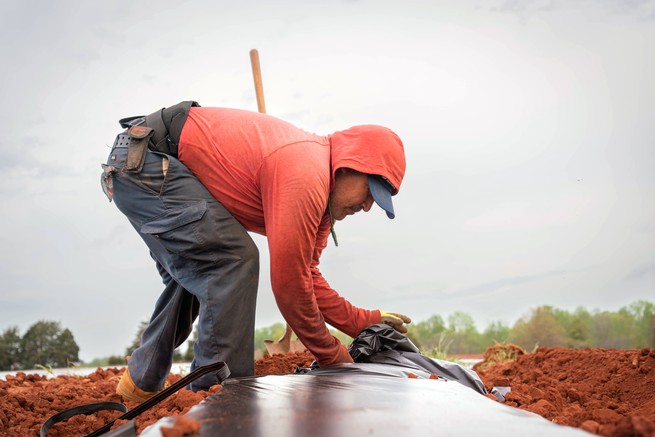Giant Heaps of Plastic Are Helping Vegetables Grow
6 min read
Each year, on our fruit-and-vegetable farm in New England, my family covers about a quarter of our 50 acres with plastic mulch. Rolls of it, five feet wide and 4,000 feet long, sit on a machine that my father and I cordially call the plastic layer. From the back of a tractor, it feeds out the mulch over a perfectly raised bed, before turning soil onto the plastic’s edges to hold it tightly for the growing season. At the end of each row, the machine stops and raises up. I walk over, throw my leg across a three-foot-wide mound, and plunge my shovel through the thin layer of plastic until it’s free from the tractor. Over the next few months, tomatoes, squashes, and melons will grow in these beds much more efficiently because of the mulch. But at the end of the growing season, we will be left with a heap of used and useless plastic.
We will return to the fields and slice the rows down the center, gripping one flap at a time and wiggling, pulling, kicking the buried edge out from under the soil. By the end of a row, the plastic—already tattered by weeds, degraded by the sun’s ultraviolet rays, and caught by feet and tractor tires—has ripped countless times. I try to roll it up neatly, but thin plastic coated in dirt, plant remnants, rotten tomatoes, and a slime of biofilm is nothing neat. I drive to a corner of the farm and dump the plastic on the same pile that my grandfather started 40 years ago.
Growing on plastic mulches has been the industry standard for decades. It makes the most sense financially for farmers; in many ways, it makes the most sense environmentally, too. Using plastic mulch saves water; it reduces the use of chemical pesticides; it increases a farm’s yield. It also means that each year the United States must somehow dispose of more than 100 million pounds of plastic—at times, the annual total has been estimated to be upwards of 200 million pounds—easily enough plastic to cover most or all of Rhode Island.
Mulches and other agricultural plastics just scratch the surface of the world’s plastic problem. Packaging, textiles, cars, and every other sector that depends on plastic produces waste. But because plastic mulches are typically too thin and too dirty to easily recycle, it is frequently infeasible or too expensive to turn them into new plastic mulches. Most become garbage, a single-use plastic whose utility is tough to replicate but that creates intractable waste.
In Florida, where the sun shines warmer than at home, the rows of plastic stretch out farther, touching the horizons. There plastic is laid daily in quantities that would cover the entirety of my family’s farm. Buddy Hill manages thousands of acres of tomatoes, and he told me that “you can’t make the yield on bare ground that you can on plastic. It’s a night-and-day difference.” The benefits for each crop vary, but for tomatoes, studies have found increases in yield by as much as a third when tomatoes are grown on plastic mulch instead of bare ground, a comparable increase to most of the plant’s fruit and vegetable counterparts.
In other words, plastics in agriculture, or plasticulture, changed what was considered possible for fruit and vegetable crops. Plastics cover greenhouses and allow for growing beyond the constraints of seasons. Small plastic tubes laid beneath the plastic mulch slowly drip water to the area where the crops need it, improving irrigation and using water up to 80 percent more efficiently than aboveground systems. Lower water volumes wash fewer fertilizers out of the soil and into local waterways and ecosystems. Plastic mulch also moderates soil temperature and disease prevalence. And it keeps weeds in check: Under those thin plastics, the heat and lack of light kill any weeds that begin to sprout. Fewer weeds means fewer chemicals needed to control weed growth, and fewer hours spent pulling weeds by hand.
Alternatives to plastic mulch—mainly, biodegradable plastic mulches—do exist. But they are more expensive and, depending on the crop and the climate, may degrade more or less quickly than the farmer needs them to. Farmers either lose the benefit of the mulches when they degrade too quickly, or end up with intact mulches that restrict their ability to cultivate later crops. Agricultural areas in California and Florida, where planting happens multiple times each year, need plastic that can be completely removed for quick crop turnarounds.
Plasticulture fits better in the system of commercial agriculture, designed to feed people efficiently. Small-scale, highly labor-intensive farms might be able to avoid both plastic use and industrially refined fertilizers and pesticides. But as long as the economics of growing food in places with ample space and shipping it around the country make sense, the mounds of dirty plastic will keep accumulating.

Farmers have a few other options. Piling up used plastic in a corner of the farm might work at first for small operations, but as the pile grows, pieces ride the wind and end up in neighboring fields, forests, and waterways. Eventually the pile of old plastic needs to be disposed of. On our farm, as on many other Massachusetts farms, that pile—40 years’ worth of mulch—was hauled away to a landfill or incinerator one dumpster at a time. In other states, including Florida, where open burning is allowed, black smoke billows from piles scattered across farms—another stream of carbon pumping into the atmosphere. Plastic is a product of fossil fuels; both its creation and disposal make it one of the biggest contributions to global warming.
In Stuttgart, Arkansas—Rice and Duck Capital of the World, a welcome sign declares—Revolution Sustainable Solutions is making recycling work. The company gathers dirty plastic from the miles of surrounding farmland, as well as from collection centers throughout the Midwest, then chops the plastic into manageable pieces, washes it, shreds it into flakes, washes it again, and dries it. The company then extrudes the flakes into plastic resins, much of which becomes trash bags.
These thin products could be ruined if a grain of sand made its way into the production line. So Revolution focuses on collecting polytube (used for irrigation) and silage bags, the long, tall, caterpillar-looking tubes that store animal feed, both of which are thicker than plastic mulches and therefore less contaminated. The greater surface area of plastic mulch holds more dirt; some mulches, to increase their strength and reduce their thickness, are embossed with a pattern that holds on to even more contamination. Plastic recycling generally follows the same script: Take something large and dirty, chop and clean it, then extrude. But whereas polytube and silage bags might be worth washing to recycle, used plastic mulch can be up to 80 percent contamination by weight, requiring extensive cleaning. It usually costs more to recycle than it does to make it new.
Karl Englund, an environmental-engineering professor and extension specialist at Washington State University, specializes in exactly this type of low-value feedstock. One key to making mulch viable for recycling, he told me, could be to find outlets that do not require clean feedstock. Mulch could be turned into highway barriers, for instance, or specialized incinerator fuel, which, in the right environment, burns cleaner than coal. Or the mulch could be dry-cleaned, or gathered in a way that helps it leave the field with less contamination. Most of these ideas, though, are still in an experimental phase.
As spring arrives on my family’s Massachusetts farm, we are organizing our supply of plastic mulches. Black rolls for early crops, helping to warm the soils; white ones for the mid-season crops, reflecting some of the sun’s heat; and biodegradable mulches for the melons and other crops that sprawl and naturally retain soil moisture and suppress weeds once established. A few remnants of last year’s biodegradable films flap in the wind among the cover crops emerging throughout our fields. Our 50-acre farm, just like the farms with thousands of acres in Florida, California, and around the world, functions within a system that works for the moment but that is contributing, season by season, year by year, to a future where the piles of plastics gathered throughout the world become altogether unmanageable.



